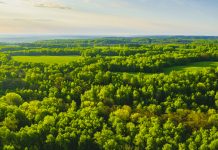Open Access Government highlights the role of forests within biodiversity and how the USDA supports agroforestry in America
Forests are said to play one of the most important roles in biodiversity. They cover 31% of the world’s surface, with the US and Canada being 2 of the 5 countries with the biggest forest areas worldwide. As well as playing a role in the environment, forests also provide more than 10% of the GDP in many poorer countries and the forestry sector is estimated to provide formal employment for 10 million people. In order to protect our forests and reduce deforestation, which occurs in many countries, sustainable forest management is key.
To ensure the protection of forests and its wildlife, the Food and Agriculture Ogranization of the United Nations (FAO) works to improve knowledge on sustainable forest and wildlife management. It also supports the development of policies and practices to improve the capacity of forests, conserve biodiversity, as well as sustain wildlife populations.
According to the FAO report, ‘State of the World’s Forests 2016’, forests play key roles in water cycle soil conservation, carbon sequestration and habitat protection, as well as their sustainable management being crucial for sustainable agriculture and food security.
USDA and agroforestry
The US Department of Agriculture (USDA) also plays a role in developing healthy forests. Agroforestry is a process that combines both agriculture and forest technologies in order to create more integrated, diverse, productive, and sustainable land-use systems.
The USDA Agroforestry Strategic Framework aims to provide new direction on how USDA agencies, partners, and landowners can together significantly expand agroforestry to balance agricultural production with natural resource conservation.
USDA states that the key concept in agroforestry is ‘working trees – putting the right tree in the right place, for the right purpose’.
Through their strategic framework, the US agroforestry community is provided with an opportunity to positively influence the long-term health and sustainability of all lands for future generations.
Supporting forests using farming techniques
There are a number of farming techniques that utilise and support forests. These are intended to make the best use of available, land, especially in rural areas, and work alongside nature without clearing areas of forest or disturbing habitats or natural processes.
Silvopasture is the practice of grazing livestock in fields with trees. This provides the animals with shelter and shade and allows them to use the same area for producing wood. This lowers stress in animals and provides a dual income for farmers, as well as preserving natural habitats and reducing the risk of wildfires.
Agrocropping involves planting trees or shrubs in rows to provide alleys in which to plant crops for fruit, vegetables, herbs, and biofuels. Again, it allows for a dual use of land and is more environmentally friendly than normal farming practices. It also allows for a better use of nutrients within the same space, as the plants and trees selected can make the best use of the soil environment and complement each other’s development.
Forest farming is a specialised practice that uses the protection of forest canopies to produce valuable crops such as shitake mushrooms and other specialty ingredients. This also allows for additional income through timber production and provides a chance for more specific products like hazelnuts and maple syrup to be produced.
The USDA supports scientific research into agroforestry, with the intention of improving the cost-effectiveness and produce yield for farmers. They aim to educate farmers and allow for more opportunities for agroforestry, leading a global support for sustainable farming.
Agriculture can often pose a threat to biodiversity, with areas of land being cleared and repurposed, and natural food chains being disturbed. Agroforestry techniques provide a method of maintaining biodiversity, but the USDA has a number of directives for achieving this. In the face of climate change and ever-increasing demands for food, maintaining the natural environment is becoming a more difficult and essential task.
The USDA’s mission statement seeks to improve the relationship between agriculture and the natural environment. Their suggestions for ensuring the protection of biodiversity include:
- Assessments to identify at risk species and environments;
- Ensuring genetic diversity to increase resilience of wildlife;
- Identifying patterns of growth and decline, as well as changes in behavior;
- Integrating climate protection into agriculture practice.
Farming systems must adapt in order to both meet increasing demands and maintain the environment at a time when it is at risk. The USDA is taking a systematic, ongoing approach to making environmental protection an essential part of farming.
Open Access Government











